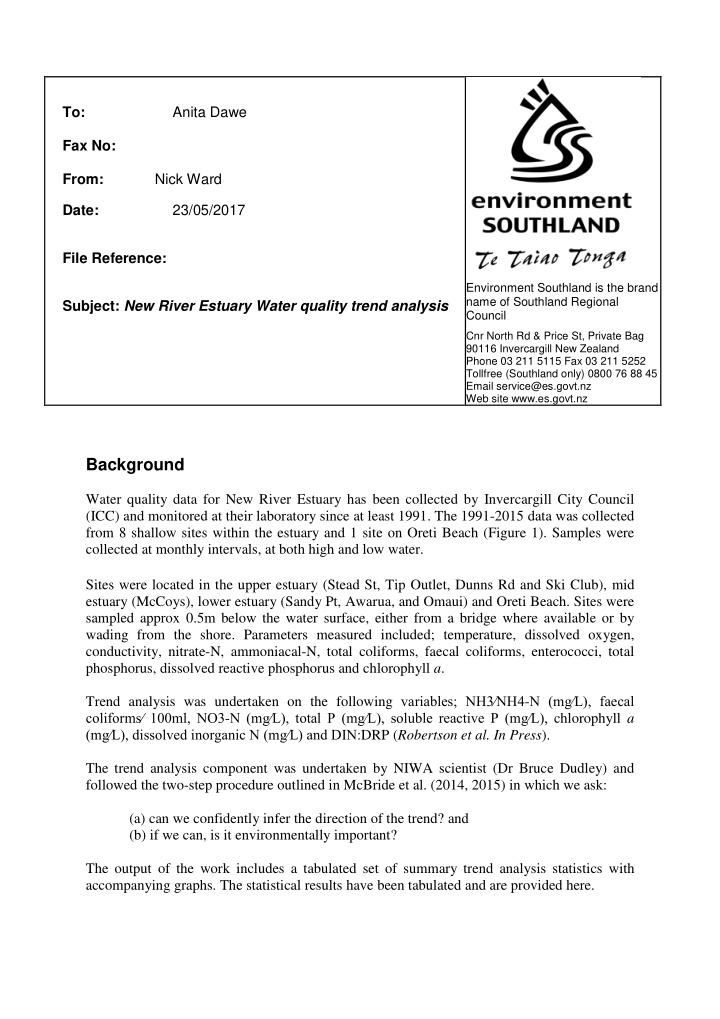



To: Anita Dawe Fax No: From: Nick Ward Date: 23/05/2017 File Reference: Environment Southland is the brand name of Southland Regional Subject: New River Estuary Water quality trend analysis Council Cnr North Rd & Price St, Private Bag 90116 Invercargill New Zealand Phone 03 211 5115 Fax 03 211 5252 Tollfree (Southland only) 0800 76 88 45 Email service@es.govt.nz Web site www.es.govt.nz Background Water quality data for New River Estuary has been collected by Invercargill City Council (ICC) and monitored at their laboratory since at least 1991. The 1991-2015 data was collected from 8 shallow sites within the estuary and 1 site on Oreti Beach (Figure 1). Samples were collected at monthly intervals, at both high and low water. Sites were located in the upper estuary (Stead St, Tip Outlet, Dunns Rd and Ski Club), mid estuary (McCoys), lower estuary (Sandy Pt, Awarua, and Omaui) and Oreti Beach. Sites were sampled approx 0.5m below the water surface, either from a bridge where available or by wading from the shore. Parameters measured included; temperature, dissolved oxygen, conductivity, nitrate-N, ammoniacal-N, total coliforms, faecal coliforms, enterococci, total phosphorus, dissolved reactive phosphorus and chlorophyll a . Trend analysis was undertaken on the following variables; NH3⁄NH4 - N (mg⁄L), faecal coliforms⁄ 100ml, NO3 - N (mg⁄L), total P (mg⁄L), soluble reactive P (mg⁄L), chlorophyll a (mg⁄L), dissolved inorganic N (mg⁄L) and DIN: DRP ( Robertson et al. In Press ). The trend analysis component was undertaken by NIWA scientist (Dr Bruce Dudley) and followed the two-step procedure outlined in McBride et al. (2014, 2015) in which we ask: (a) can we confidently infer the direction of the trend? and (b) if we can, is it environmentally important? The output of the work includes a tabulated set of summary trend analysis statistics with accompanying graphs. The statistical results have been tabulated and are provided here.
A simplified overview of how these statistics are to be interpreted was also provided as follows: • Does the range between the 5% and 95% confidence intervals in the Time Trends output for the slope intersect zero? • If not (i.e. for a positive trend both are above zero or for a negative trend they are both below zero) one can confidently assert that the trend is significantly different from zero. • Some indication of the strength of the trend in the data may be gleaned from the p value (column d), although p values above 0.05 are NOT sufficient evidence to suggest that no trend exists in the data, but only that we can say that the null hypothesis (there is no trend) is ‘not rejected’ (at p=0.05). • If a trend exists, the next step is to ask whether or not it is ecologically important. This should be based on expert opinion (e.g., if N was a limiting nutrient to algal growth in the New River estuary in 1991, a small annual nitrate change after that time may be considered ecologically important. This is informed by the ‘Percent annual change’. In other studies of river water quality it has been observed that Kendall Trend Tests have been used (e.g., Vant and Wilson 1998; Vant 2013), trends >=1% p.a. have been considered ‘important’, whereas trends with slopes less than that were considered ‘slight’.
Figure 1. New River Estuary, showing location of ICC water quality monitoring sites (Photo LINZ)
Results Table 1. All Year, Seasonal Kendall test with multiple values/season (both high and low water, summer and winter). Note that a positive trend indicates deterioration and a negative trend indicates an improvement.
Table 2. Summer Only, Seasonal Kendall test with multiple values/season (both high and low water, summer). Note that a positive trend indicates deterioration and a negative trend indicates an improvement.
References McBride, G., Snelder, T., Unwin, M., Booker, D., Verburg, P. and Larned, S. 2015. “A new approach to water quality trend assessment” Appendix A in Larned, S. et al. Analysis of Water Quality in New Zealand Lakes and Rivers. Prepared for Ministry for the Environment, NIWA Client Report CHC2015-033, Project MFE15503, 74 p. plus Appendices.5 Barr, N.G. et al., 2013. Broad-scale patterns of tissue- d 15 N and tissue-N indices in frondose Ulva spp .; Developing a national baseline indicator of nitrogen-loading for coastal New Zealand. Marine Pollution Bulletin, 67(1-2), pp.203–216. Available at: http://dx.doi.org/10.1016/j.marpolbul.2012.11.033. McBride, G.B., Cole, R., Westbrooke, I. and Jowett, I.G. 2014. Assessing environmentally significant effects: A better strength-of-evidence than a single P value? Environmental Monitoring and Assessment 186(5): 2729– 2740. doi: 10.1007/s10661-013-3574-8. Vant, B., Wilson, B. (1998) Trends In River Water Quality In The Waikato Region, 1980–97. Environment Waikato technical report, 1998/13 . Vant, B. (2013) Trends in river water quality in the Waikato region, 1993-2012. Waikato Regional Council Technical Report , 2013/20: 50. ISSN 2230-4355 Robertson, B.M., Steven & L.M., Dudley, B. (In Press). New River Estuary - review of water quality data in relation to eutrophication 1991-2015. Report prepared by NIWA and Wriggle Coastal Management for Environment Southland. 32p.
Recommend
More recommend